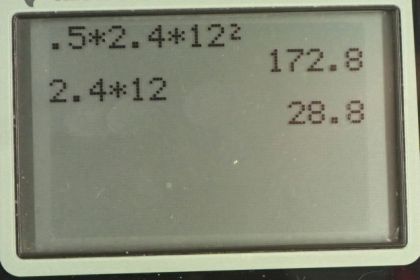Question
While entering a freeway, a car accelerates from rest at a rate of for 12.0 s. (a) Draw a sketch of the situation. (b) List the knowns in this problem. (c) How far does the car travel in those 12.0 s? To solve this part, first identify the unknown, and then discuss how you chose the appropriate equation to solve for it. After choosing the equation, show your steps in solving for the unknown, check your units, and discuss whether the answer is reasonable. (d) What is the car's final velocity? Solve for this unknown in the same manner as in part (c), showing all steps explicitly.
Final Answer
- Please see the solution video
- , , , ,
Solution video
OpenStax College Physics, Chapter 2, Problem 24 (Problems & Exercises)

vote with a rating of
votes with an average rating of
.
Calculator Screenshots
Video Transcript
This is College Physics Answers with Shaun Dychko. This question asks you to be really methodical and I usually I am and I always start questions off by writing down the things that we know. So we know this car starts at rest so that's 0 meters per second for v naught; the acceleration is 2.40 meters per second squared and the total time that it spends accelerating is 12.0 seconds. So in part (a) we draw a picture of this scenario so here's a car on the freeway and the acceleration is 2.40 meters per second squared to the right and that's true at all times, constant acceleration; we could have written that here as well if we want. And initially, there's zero velocity; we'll take this to be position zero and also time zero. And then sometime later, at 12 seconds, we don't know what the final speed or the final position will be but we do know the acceleration remains at 2.40 meters per second every second. Part (b) says write down all this stuff that you know and we have already done that. And then part (c) says figure out what the final position will be. So we are going to choose this equation number 53 in chapter 2 because the only thing that we don't know is x in this equation and that's exactly what we want to find for part (c), the final position. And so we know acceleration and we know the time and we know initial velocity and we know initial position. So this is zero for initial position and this initial velocity is 0 times— well I could have written 12 there for the time but doesn't really matter what that number is because it's being multiplied by 0 which makes 0— plus one-half times the acceleration 2.40 meters per second squared multiplied by the time which is 12 seconds and we square that time this makes a final position of 173 meters. In part (d), we choose equation 52 for the same sort of reason and that it has only one unknown and that is the thing that we want to find, the final velocity. So final velocity is initial velocity plus acceleration times time so that's 0 plus 2.40 meters per second squared times 12 seconds which gives a final velocity of 28.8 meters per second.
